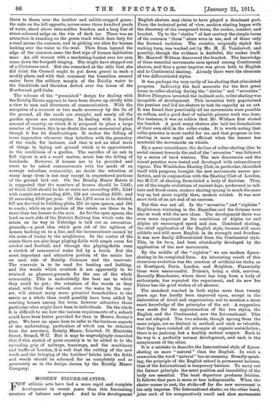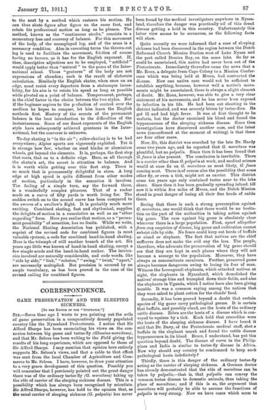MODERN FIGURE-SKATING.
FEW athletic arts have had a more rapid and complete development in recent years than this fascinating creature of balance and speed. And in this development
English skaters may claim, to have played a dominant part. From the technical point of view, modern skating began with the discovery of the compound turns, the rocker, counter, and bracket. Up to the " sixties " of last century the simple turns of the common " three " alone were in use, and of these only the forward varieties. The counter, originally styled the rocking turn, was worked out by Mr. H. E. Vandervell, and possibly, though the evidence is doubtful, the rocker itself. Mr. Maxwell Witham discovered the bracket. The knowledge of these essential movements soon spread among Continental skaters, and thus a great impetus was given both to English and to Continental skating. Already there were the elements of two differentiated styles.
It was perhaps the very rarity of ice-skating that stimulated progress. Indirect:y the fact accounts for the first great boom in roller-skating during the " sixties " and " seventies." Before Plimpton invented the inclined axle, roller-skating was incapable of development. This invention both popularised the pastime and led ice-skaters to test its capacity as an art. It was found that practically all ice movements were possible on rollers, and a good deal of valuable pioneer work was done. For instance, it was on rollers that Mr. Witham first skated the bracket. A good many skaters also laid the foundations of their own skill in the roller-rinks. It is worth noting that roller-practice is most useful for ice, and that progress in ice- skating is more rapid and efficient when the learner has mastered the movements on wheels.
By a queer coincidence, the decline of roller-skating (due to social causes) towards the end of the " seventies " was followed by a series of hard winters. The new discoveries and the recent practice were tested and developed with extraordinary vigour. The Wimbledon. Skating Club, in particular, identified itself with progress, brought the new movements nearer per- fection, and in conjunction with the Skating Club of London, the M.C.C. of skating, formulated a body of doctrine. Thus, out of the simple evolutions of ancient days, performed in tall- hats and frock-coats, modern skating sprang in much the same way as, but more rapidly than, modern cricket. It was now more both of an art and of an exercise.
But this was not all. In the " seventies " and " eighties " Englishmen wintering in the Engadine and the Grisons were also at work with the new ideas. The development there was even more important as the conditions of Alpine ice and Alpine air encouraged speed and size.. Combined skating, the chief application of the English style, became still more athletic and still more English in its strength and freedom. It was now finally differentiated from the Continental style. This, in its turn, had been abundantly developed by the application of the new movements.
By the middle of the "eighties". we see modern figure- skating in its completed form. An interesting result of this strenuous evolution was the erection of artificial-ice rinks, as at Southport., Paris, London, and Brighton. Financially these were unsuccessful. Prince's, being a club, survives. Recently Manchester, where there has long been a body of enthusiasts, has repeated the experiment, and its new Ice Palace has the good wishes of all skaters.
The standard reached in both styles more than twenty years ago has hardly been improved upon, except in the elaboration of detail and organisation, not to mention a more exact knowledge of the principles of the art. A suggestion was made for the approximation of the two styles, the English and the Continental, now the International. This was not adopted. The two schools, though sprung from the same origin, are so distinct in' method, and each so valuable, that they have resisted all attempts at organic assimilation ; there is no jealousy, but a healthy mutual respect. Each in its way is a perfectly normal development, and each is the complement of the other.
It is a mistake to describe the International style of figure- skating as more " natural " than the English. In such a connexion the word "natural " has no meaning. Broadly speak- ing, the principle of the English school is permanent balance, that of the International is temporary balance. To carry out the former principle the erect position and immobility of the body are essential. The least departure produces friction. It follows that pace is more or less indispensable. When the skater comes to rest, the strike-off for the new movement is his only impetus. The International skater, on the other hand, joins each of his comparatively small and slow movements to the next by a method which restores his motion. He can thus skate figure after figure on the same foot, and retain his professional motion as long as he pleases. The method, known as the " continuous stroke," consists in a momentary loss and recovery of balance. For this movement of the body, of the unemployed leg, and of the arms is a necessary condition. Also in executing turns the thrown-out leg is used to facilitate the movement, friction of course having no terrors, as it has for the English exponent. If, then, descriptive adjectives are to be employed, " artificial " would apply better than "natural " to the poses of the Inter- national school. These "gestures" of the body are not expressions of abandon; each is the result of elaborate calculation. Similarly the English skater, when once on an edge, must resist every departure from a statuesque immo- bility, for his aim is to retain his speed as long as possible while pivoted on a point of balance. Temperament, perhaps, is the chief factor in the choice between the two styles. But if the beginner aspires to the perfection of control over the medium he hopes to conquer, let him learn the English methods first. Mastery of the secrets of the permanent balance is the best introduction to the difficulties of the instantaneous. Some of our finest exponents of the English style have subsequently achieved greatness in the Inter- national, but the converse is unknown.
To-day skating is "in the air " ; roller-skating is to be had everywhere; Alpine sports are vigorously exploited. Yet it is strange how few, whether on steel blades or aluminium wheels, get beyond the elements. It is, perhaps, the first step that costa, that on to a definite edge. Here, as all through the skater's art, the secret is attention to balance. And it is worth while getting over this first step. There is so much that is permanently delightful in store. A long edge at high speed is quite different from other modes of motion, particularly in the sensation it involves. The feeling of a simple turn, say the forward three, is a wonderfully complex pleasure. That of a rocker made on a curve of fifty yards is worth living for. The sudden switch on to the second curve has been compared to the swerve of a swallow's flight. It is probably much more exciting. Combined skating, fast and rhythmical, supplies the delights of motion in a cumulative as well as an "other regarding" form. Here you realise that motion, as a "perma- nent possibility" of sensation, has no limits. While we write, the National Skating Association has published, with a reprint of the revised code for combined figures (a most valuable system), a code for combined hand-in-hand skating. Here is the triumph of still another branch of the art. Six years ago little was known of hand-in-band skating, except a few simple scuds and the band-in-hand rocker. The intrica- cies involved are naturally considerable, and code words, like " side by side," " link," "echelon," " swing," " twist," "apart," are necessarily multiplied. But precision is secured by an ample vocabulary, as has been proved in the case of the revised calling for combined figures.











































 Previous page
Previous page